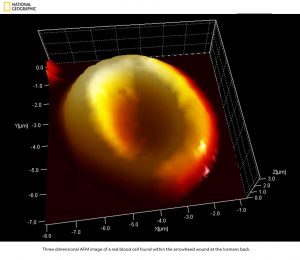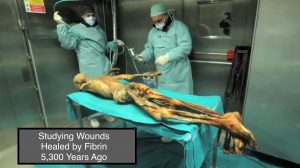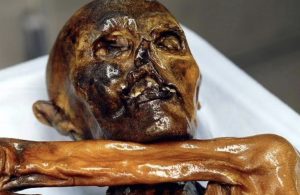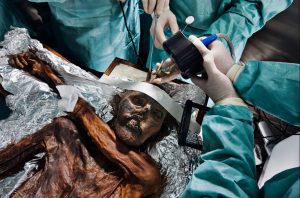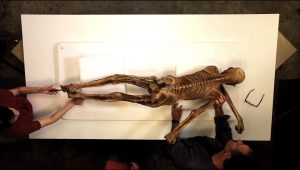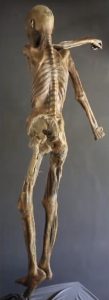Research findings in the relatively new field of Regenerative Medicine have allowed spine expert, Dr. Kevin Pauza to define previously unknowable details about the death of Ötzi the Iceman 5,300 years ago.
Many people learned of Ötzi the Iceman through news articles, a feature movie, or documentaries from National Geographic, the Smithsonian, or PBS NOVA. However, all these commentaries have failed to correctly define one of the most intriguing aspects of the Iceman: how his life ended. Every version of Ötzi’s story ended inconclusively or with an inaccurate resolution, until now.
Thanks to Dr. Kevin Pauza’s research, we now know the truth about Ötzi the Iceman’s death.
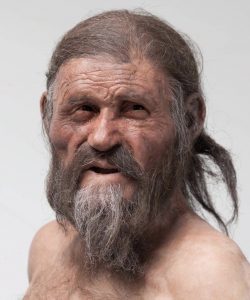 Who was Ötzi the Iceman?
Who was Ötzi the Iceman?
Ötzi the Iceman lived a thousand years before the construction of the Great Pyramids, before the construction of Stonehenge, and even before the invention of writing in Mesopotamia. He was given the name Ötzi because he lived in the snow-covered Ötztal Alps, which span the region between Austria and Italy.
In 1991, unsuspecting Alpen climbers uncovered the remains of Europe’s oldest known human, offering an unprecedented view into our distant past.
Even though science was not yet advanced enough to answer experts’ questions, those experts were smart enough to “put him on ice.” Ötzi remained frozen in a Museum in Bolzano, Italy, near the location of his original frozen entombment over 5,300 years ago, until science caught up.
Ötzi the Iceman’s Death
The circumstances of Ötzi’s death have been the subject of much investigation and speculation, with details eluding scholars and expert panels. Details of his death, thought to be murder, were inconclusive.
Ötzi is believed to have been murdered. Experts came to this conclusion after finding an arrowhead in his left shoulder, which they believe caused profuse bleeding from his Subclavian Artery, resulting in immediate and pain-free death.
 How Dr. Pauza Met Ötzi the Iceman
How Dr. Pauza Met Ötzi the Iceman
Some years ago, during a dinner at the Vatican, where Dr. Pauza had just been dispatched from the USA, Ötzi the Iceman came up in conversation.
Dr. Pauza was visiting the city in order to treat the spine of one of its residents, as he has often been asked to provide his spine expertise to help diplomats and political or religious leaders.
This particular visit to the Vatican stands out in his memory because of a conversation that took place at the Vatican’s dinner table, discussing Ötzi’s discovery by hikers years earlier. Controversy erupted because the timeline associated with Ötzi’s remains didn’t mesh well with the Bible’s timeline.
Initially, Ötzi’s remains were believed to belong to a wayward mountain climber lost decades earlier. This changed after his belongings were discovered on the slope, leading experts to believe that he was centuries old.
However, shortly before Dr. Pauza’s visit to the Vatican, Carbon Dating placed Ötzi on Earth over 5,000 years ago. This changed everything because it proved that Ötzi wasn’t just a lost climber, but was someone who lived in advanced civilization thousands of years before Jesus walked the Earth.
Now the church, scientists, and the whole world shared in the discussion. The Iceman lived and died in the mountains, not too terribly far from the Vatican. Over trout, corn, and mushrooms, the conversation at the Vatican revolved around how the Iceman’s life intermingled with events of the Bible.
Little did Dr. Pauza know that decades later, his research using Fibrin, an FDA-approved substance, to heal the spine by making it younger would provide him the closest possible look into Ötzi’s life and death.
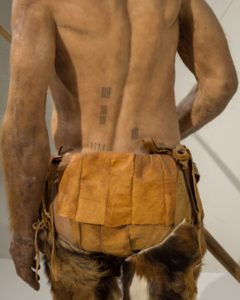 Dr. Pauza’s New Understanding of the Iceman’s Death
Dr. Pauza’s New Understanding of the Iceman’s Death
Dr. Pauza was able to determine the precise time frame associated with healing injuries and the biologic characteristics associated with those healing times, he has been able to accurately describe the events leading up to Ötzi the Iceman’s death.
According to Dr. Pauza, when we heal, a material called Fibrin, which is present inside all of us, causes us to heal. When this happens, Fibrin displays specific characteristics throughout healing. Because those specific characteristics were perfectly preserved in Ötzi the Iceman’s frozen body, it allowed Dr. Pauza to peer through a window to see events that occurred over 5,300 years ago.
Dr. Pauza’s interpretation of data, collected using three-dimensional Atomic Force Microscopy (AFM), revealed insight allowing us to now have more details about Ötzi the Iceman’s life than even the Iceman knew about himself. By analyzing what was locked within his frozen blood and tissue healing, Dr. Pauza was able to find information that even the archeological experts missed during their decades of studying him.
Archeological scientists originally concluded that Ӧtzi lived in relatively good health, followed by a quick and painless death due to bleeding from a single fatal stab to the base of his neck. However, his final hours were very different from this previous conclusion.
“Prior archeological studies detailing the Iceman’s life and death are excellent,” says Dr. Pauza, “but because they lacked the scientific tools and data available to us today, their conclusions were wrong.”
Fibrin’s Role in Healing
In order to decipher the details of Ötzi the Iceman’s death, Dr. Pauza employed new knowledge gleaned from his team’s research of Fibrin for off-label use.
Fibrin is a natural molecule found in every human, and it has the unique ability to heal and regrow damaged tissue. Dr. Pauza’s team studies Fibrin for off-label use because they’re successfully using it to treat spinal diseases and degeneration. It’s replacing spine surgery with great success.
“Understanding Fibrin and its ability to heal is critical to the future of humans. So many scientists are focused on medical inventions allowing humans to live longer lives, but that’s not good enough. Because what good is living longer if we’re not living with high quality, Living without pain? that’s my focus, giving humans quality years, not just quantity. And we’re improving the quality of our time alive by regenerating our tissue and organs. Using Fibrin to make our bodies younger as we grow older, because Fibrin has the critical role of healing every injury and wound in the human body.”
Dr. Kevin Pauza
Understanding Fibrin and wound healing allowed Dr. Pauza to correct erroneous conclusions about Ötzi’s death. Although every expert believed the Iceman’s death was quick and painless, caused by profuse bleeding, Dr. Pauza was able to show instead that Ötzi’s last weeks of life and his death were anything but quick and painless.
To understand how Dr. Pauza was able to describe Ötzi’s last weeks of life along with his death requires scientists to understand recent scientific advances. These advances include
three-dimensional AFM (Atomic Force Microscopy) and using AFM to calculate Young’s Modulus Equation.
“It’s actually simple,” states Dr. Pauza, “Understanding this equation of life is as simple as understanding the New York Times’ Sudoku.” Plugging the data from Dr. Pauza’s research findings into this equation led Dr. Pauza to accurately reconstruct Ötzi the Iceman’s death.
You can read more about how Dr. Pauza’s Fibrin research is revolutionizing spine procedures here
